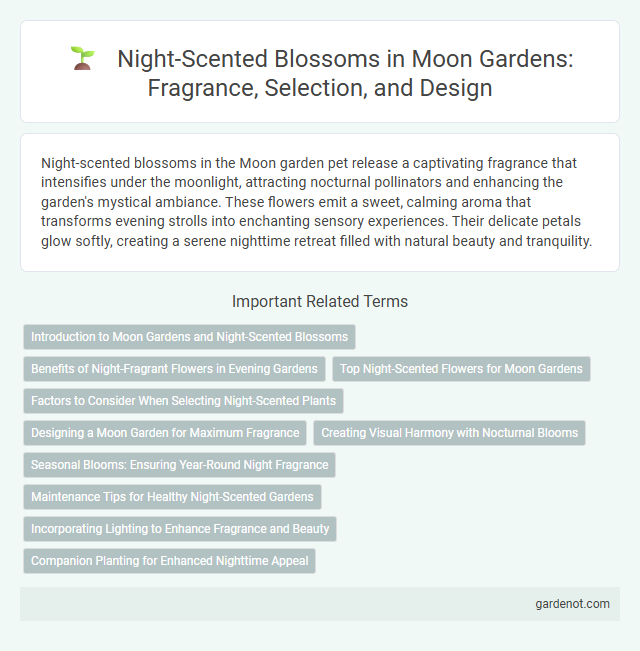Night-scented blossoms in the Moon garden pet release a captivating fragrance that intensifies under the moonlight, attracting nocturnal pollinators and enhancing the garden's mystical ambiance. These flowers emit a sweet, calming aroma that transforms evening strolls into enchanting sensory experiences. Their delicate petals glow softly, creating a serene nighttime retreat filled with natural beauty and tranquility.
Introduction to Moon Gardens and Night-Scented Blossoms
Night-scented blossoms, such as night-blooming jasmine and evening primrose, are essential elements of moon gardens designed to thrive under moonlight and release intoxicating fragrances after dusk. These flowers attract nocturnal pollinators like moths, enhancing biodiversity while creating a serene sensory experience with their luminous petals and sweet scents. Incorporating night-scented blossoms in moon gardens transforms outdoor spaces into tranquil retreats that come alive with fragrance and subtle visual beauty at night.
Benefits of Night-Fragrant Flowers in Evening Gardens
Night-scented blossoms release potent fragrances that enhance the sensory experience of evening gardens, attracting nocturnal pollinators like moths and bats essential for plant reproduction. Their aromatic presence fosters a calming ambiance, promoting relaxation and stress reduction for nighttime visitors. These flowers also contribute to biodiversity by supporting nighttime ecosystems, making them vital components of sustainable garden design.
Top Night-Scented Flowers for Moon Gardens
Night-scented blossoms such as the Evening Primrose, Night-Blooming Jasmine, and Four O'Clock flower are ideal choices for moon gardens due to their strong fragrance released at night. These flowers attract nocturnal pollinators like moths and bats, enriching the biodiversity of the garden environment. Incorporating such night-scented blooms enhances the sensory experience, providing sweet, lingering scents under moonlight.
Factors to Consider When Selecting Night-Scented Plants
Selecting night-scented plants for a moon garden involves evaluating fragrance intensity, bloom time, and plant compatibility with nighttime pollinators like moths and bats. Climate adaptability and maintenance requirements are critical to ensure the plants thrive in evening conditions and complement the garden's lunar ambiance. Prioritizing species such as Night-Blooming Jasmine and Evening Primrose optimizes sensory impact while enhancing nocturnal biodiversity.
Designing a Moon Garden for Maximum Fragrance
Night-scented blossoms such as evening primrose and night-blooming jasmine release their strongest fragrances during twilight, making them essential for an immersive Moon Garden experience. Position these plants near patios, walkways, or seating areas to maximize their aromatic impact as darkness falls. Incorporating night-scented blossoms with complementary foliage enhances both visual appeal and olfactory delight, creating a tranquil nocturnal retreat.
Creating Visual Harmony with Nocturnal Blooms
Night-scented blossom enhances a Moon garden by releasing a delicate fragrance that complements the soft glow of moonlit petals. Its pale, star-shaped flowers create visual harmony with other nocturnal blooms like white jasmine and silvery-leaved dusty miller. Strategically planting these aromatic flowers ensures a captivating sensory experience that unites scent and sight in moonlit landscapes.
Seasonal Blooms: Ensuring Year-Round Night Fragrance
Night-scented blossoms such as moonflowers, night-blooming jasmine, and evening primrose play a vital role in maintaining a continuous nocturnal fragrance in moon gardens. These seasonal blooms thrive in specific months, with moonflowers peaking in summer and night-blooming jasmine releasing scents from late spring through fall. Strategic planting of diverse night-scented species ensures an uninterrupted aromatic experience, enhancing the garden's allure throughout the year.
Maintenance Tips for Healthy Night-Scented Gardens
Night-scented blossoms thrive in well-drained soil with consistent moisture, requiring regular watering during dry spells to maintain vibrant blooms. Pruning after the flowering season encourages healthy growth and prevents legginess, while mulching helps retain soil moisture and suppress weeds. Monitoring for pests like aphids and treating infestations promptly ensures the night-scented garden remains lush and aromatic throughout the season.
Incorporating Lighting to Enhance Fragrance and Beauty
Night-scented blossoms emit a captivating fragrance that intensifies under strategic lighting in a Moon garden. Soft LED or solar-powered lights placed near these flowers enhance their delicate petals' visibility while amplifying their aromatic presence after dusk. Integrating gentle illumination not only highlights the blossom's beauty but also creates an enchanting nighttime ambiance that attracts pollinators and enriches the sensory experience.
Companion Planting for Enhanced Nighttime Appeal
Night-scented blossoms, such as Nicotiana alata, thrive when companion planted with moonflowers and white evening primroses, enhancing the moon garden's nighttime allure. These plants release fragrant aromas after dusk, attracting pollinators like moths and boosting the garden's sensory appeal under moonlight. Strategic placement near seating areas or pathways maximizes their fragrance impact, creating a soothing nocturnal atmosphere.
Night-scented blossom Infographic

 gardenot.com
gardenot.com